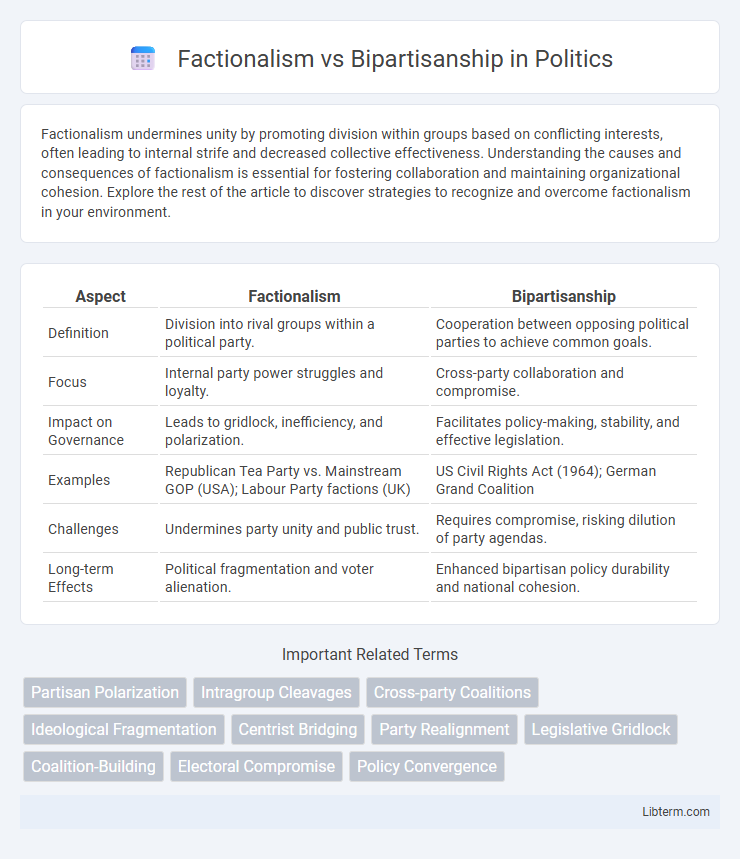Factionalism undermines unity by promoting division within groups based on conflicting interests, often leading to internal strife and decreased collective effectiveness. Understanding the causes and consequences of factionalism is essential for fostering collaboration and maintaining organizational cohesion. Explore the rest of the article to discover strategies to recognize and overcome factionalism in your environment.
Table of Comparison
| Aspect | Factionalism | Bipartisanship |
|---|---|---|
| Definition | Division into rival groups within a political party. | Cooperation between opposing political parties to achieve common goals. |
| Focus | Internal party power struggles and loyalty. | Cross-party collaboration and compromise. |
| Impact on Governance | Leads to gridlock, inefficiency, and polarization. | Facilitates policy-making, stability, and effective legislation. |
| Examples | Republican Tea Party vs. Mainstream GOP (USA); Labour Party factions (UK) | US Civil Rights Act (1964); German Grand Coalition |
| Challenges | Undermines party unity and public trust. | Requires compromise, risking dilution of party agendas. |
| Long-term Effects | Political fragmentation and voter alienation. | Enhanced bipartisan policy durability and national cohesion. |
Understanding Factionalism: Roots and Definitions
Factionalism arises from deeply rooted ideological, social, or economic divisions within a larger political or organizational group, resulting in organized subgroups competing for power or influence. This phenomenon often stems from conflicting interests and values that fragment unity, leading to internal rivalry and weakened cohesion. Understanding factionalism requires analyzing its origins in group dynamics, identity politics, and resource allocation struggles that drive competing agendas.
The Essence of Bipartisanship in Governance
Bipartisanship in governance embodies collaboration between opposing political parties to achieve common goals, fostering policy stability and inclusive decision-making. It enhances legislative efficiency by bridging ideological divides and prioritizing the public interest over partisan agendas. This cooperative approach strengthens democratic institutions and promotes sustainable governance through mutual respect and compromise.
Historical Contexts: Factionalism vs Bipartisanship
Historical contexts reveal that factionalism often emerged during periods of intense political realignment, such as the early American republic with the Federalists and Democratic-Republicans clashing over federal power. Bipartisanship historically flourished in times requiring national unity, exemplified by the New Deal era when Democrats and Republicans collaborated to address the Great Depression. These patterns highlight how factionalism tends to arise from ideological polarization, while bipartisanship aligns with pragmatic governance during crises.
Impacts on Policy Making: Division or Unity?
Factionalism in policy making often leads to gridlock and fragmented legislation due to competing group interests within the same party, reducing the efficiency of governance. In contrast, bipartisanship encourages collaboration across party lines, facilitating the passage of comprehensive policies and fostering political stability. The presence of factionalism or bipartisanship significantly influences legislative productivity, public trust, and the implementation of effective government programs.
Electoral Consequences: Voter Perception and Trust
Factionalism often results in voter disillusionment, decreasing trust in political institutions due to perceived instability and internal conflicts within parties. Bipartisanship tends to enhance voter confidence by promoting cooperation and consensus, which can lead to higher electoral participation and increased legitimacy of elected officials. Studies show that electorates favor parties demonstrating unity and collaboration, correlating with stronger voter retention and positive electoral outcomes.
Case Studies: Factionalism in Political Parties
Factionalism in political parties often undermines unity, as seen in the Democratic Party's internal divisions during the 2020 U.S. presidential primaries, where progressive and moderate wings clashed over policy priorities. The UK Labour Party's split in 1981, leading to the formation of the Social Democratic Party, exemplifies how factional disputes can result in lasting fragmentation and electoral setbacks. These cases demonstrate that factionalism can weaken party cohesion and electoral performance, contrasting with the stability generally promoted by bipartisanship.
Successful Examples of Bipartisanship in Legislation
Successful examples of bipartisanship in legislation include the 1997 Balanced Budget Act, where both Democrats and Republicans collaborated to reduce the federal deficit and reform Medicare. The 2010 Every Student Succeeds Act replaced No Child Left Behind with broad support from both parties, emphasizing state control over education. Bipartisan efforts also led to the First Step Act in 2018, a criminal justice reform bill aimed at reducing recidivism and improving prison conditions.
Media Influence: Amplifying Divides or Building Bridges
Media influence plays a critical role in shaping factionalism by often amplifying political divides through sensationalized coverage and echo chambers that reinforce partisan biases. Conversely, certain media outlets and platforms can promote bipartisanship by highlighting cross-party collaborations, fostering dialogue, and providing balanced perspectives. The power of media to either deepen polarization or encourage unity depends largely on editorial choices and audience engagement patterns.
Resolving Political Gridlock: Strategies for Progress
Resolving political gridlock requires fostering bipartisanship through collaborative negotiation and compromise between opposing parties to achieve legislative progress. Strategies such as establishing bipartisan committees and encouraging cross-party dialogue help break down factionalism that stalls decision-making. Emphasizing shared goals and mutual benefits can mitigate entrenched partisan divides, enabling effective governance and policy advancement.
The Future of Political Discourse: Collaboration or Conflict
Factionalism intensifies political polarization, fragmenting legislative processes and hindering policy-making, while bipartisanship fosters cooperative dialogue and pragmatic solutions across party lines. Emerging trends suggest increasing public demand for cross-party collaboration to address complex issues such as climate change, economic inequality, and healthcare reform. The future of political discourse hinges on the ability of leaders to balance ideological differences with shared goals, promoting unity without erasing essential political diversity.
Factionalism Infographic

 libterm.com
libterm.com